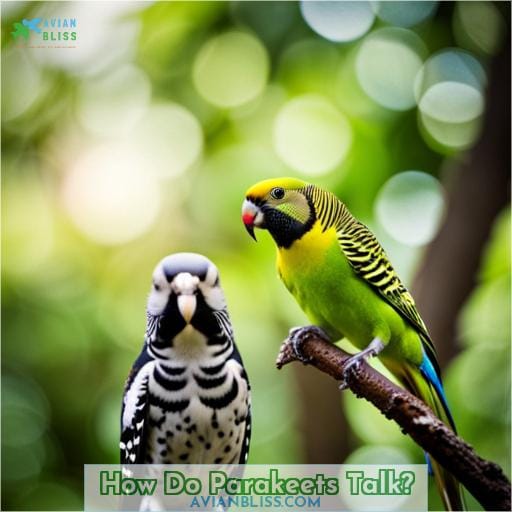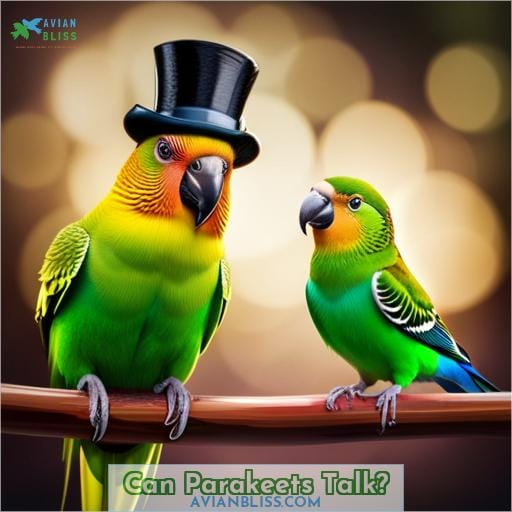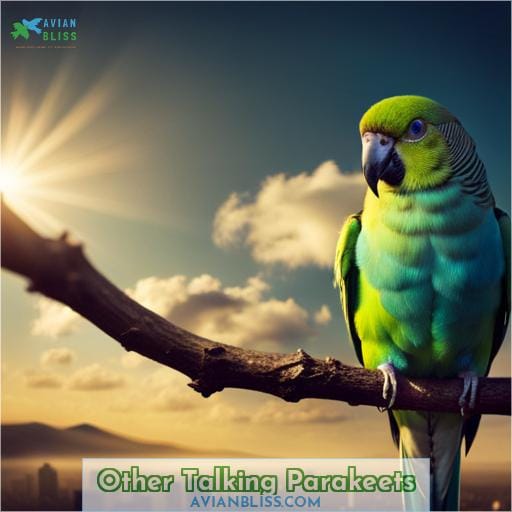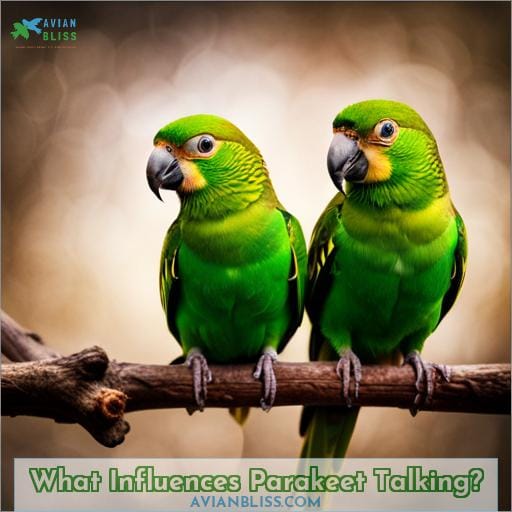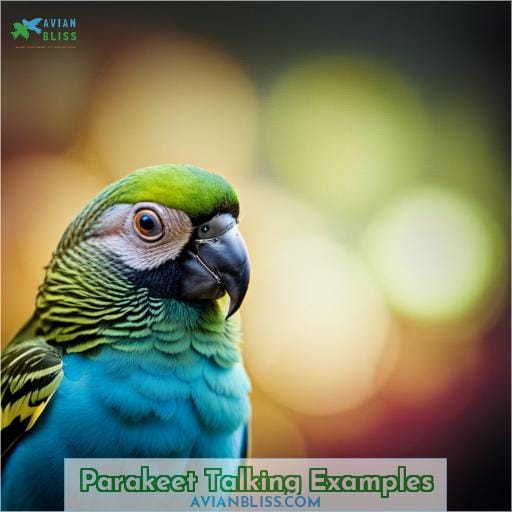This site is supported by our readers. We may earn a commission, at no cost to you, if you purchase through links.
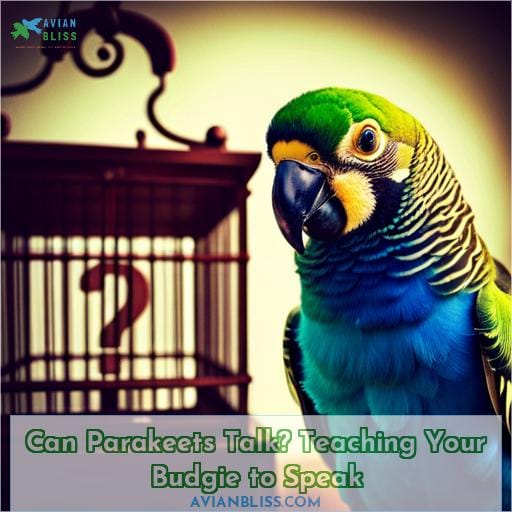 Unlock the secret to communicating with your parakeet!
Unlock the secret to communicating with your parakeet!
Have you ever wondered if these colorful birds can talk? The answer is yes, and in this article, we will show you how to teach your budgie to speak. Discover the fascinating world of parakeet sounds and learn effective techniques for training them.
Table Of Contents
Key Takeaways
- Parakeets communicate through a variety of sounds and vocalizations.
- Males are more likely to speak than females.
- Younger parakeets tend to learn how to talk easier and faster compared to older ones.
- Parakeets use their larynx (voice box) and vocal cords to produce sounds.
How Do Parakeets Talk?
To understand how parakeets talk, it’s important to know that they communicate through a variety of sounds and vocalizations.
Parakeets have the ability to learn words and expand their vocabulary at a young age. However, there are some factors that can influence their talking abilities, such as gender and age.
Males are more likely to speak than females, possibly due to their need for attracting mates. Additionally, younger parakeets tend to learn how to talk easier and faster compared to older ones.
When it comes to producing sounds for talking or making noises in general, parakeets use their larynx (voice box) and vocal cords just like humans do with our own voice boxes when we speak or sing.
While they may not fully grasp the meaning of the words they say, with proper training using repetition techniques along with positive reinforcement like treats or praise from you as an owner/trainer – your budgie will be able develop its speaking skills over time.
Common Parakeet Sounds
Parakeets make a variety of noises throughout the day, from chirping and whistling to singing and clicking.
- Chirping is a common sound that parakeets use for communication.
- Whistling often indicates their happiness.
- Screaming may indicate pain or distress.
- Singing is a sign of contentment.
- Parakeets also engage in beak grinding, which can signify relaxation and comfort.
- Additionally, they chatter to communicate with each other using contact calls or trills.
- They also click their beaks when they’re happy.
Understanding these various parakeet sounds can help you better interpret your bird’s behavior and emotions. If your parakeet seems distressed or exhibits unusual vocalizations such as excessive screaming without an apparent reason, it might be best to consult an avian veterinarian for further evaluation.
Overall, being familiar with the different sounds that parakeets make will enable you to create a deeper bond with your feathered friend while ensuring its well-being and happiness in captivity.
How to Teach a Parakeet to Talk?
To teach your parakeet to talk, you need to understand the importance of timing and repetition.
Choose a specific time of day when your bird is most alert and focused, such as in the morning or early evening.
Repeat simple words or phrases slowly and clearly, using treats as positive reinforcement.
By establishing a routine and responding to your bird’s activities, you can create an effective training environment for teaching your parakeet how to talk.
Time of the Day is Important
When teaching your budgie to speak, it’s important to consider the time of day as a crucial factor in their learning process.
- Morning: Birds are most active and alert during this time.
- Afternoon: Budgies may be more receptive to training sessions.
- Evening: A calm and relaxed environment can aid in focusing their attention.
- Night/Bedtime: Quiet surroundings promote better sleep for optimal learning.
Time of day plays an essential role in your budgie’s ability to learn new words and sounds. Take advantage of their natural energy levels by scheduling training sessions during times when they’re most alert, such as in the morning or afternoon.
In the evening, create a peaceful environment that allows them to focus on you without distractions. At night or bedtime, ensure that they’ve a quiet space for restful sleep, which is vital for memory consolidation and retention.
By considering these factors throughout the day, you can optimize your budgie’s language acquisition abilities while promoting overall well-being.
Repeat Simple Words
Once you have established a routine with your parakeet, repeat simple words consistently.
Use a clicker or whistle to capture their attention.
Be patient and reward them with millet when they mimic the word correctly.
Using a mirror can also help stimulate their talking abilities.
One Word at a Time
Start by teaching your parakeet one word at a time.
- Repeat the word over and over again.
- Reward your parakeet with a treat when it says the word.
- Use hand gestures as triggers for talking.
Use Treats
To teach your parakeet to talk, you can use treats as a reward for their progress.
Incorporate high-value treats like millet spray and use positive reinforcement during training sessions.
Be careful not to overfeed while hand-feeding treats.
Build a Routine
To build a routine for teaching your parakeet to talk, establish regular practice sessions and incorporate consistent repetition of words or phrases.
- Cover the cage to create a focused environment.
- Practice with patience and consistency.
- Use positive reinforcement and rewards.
- Maintain a structured training schedule.
Can Parakeets Talk?
If you’re wondering whether parakeets can talk, the answer is yes! Parakeets, also known as budgies, have the ability to mimic and produce sounds. While they may not be able to hold in-depth conversations like humans do, they’re capable of learning a range of words and phrases.
The age at which a parakeet starts talking can vary, but it’s generally easier to teach them when they’re younger than one year old. Interestingly, female parakeets are less likely to learn how to talk compared to their male counterparts.
Parakeets communicate with each other through various noises such as chirping and chattering. They also express happiness by whistling and singing melodies when in good spirits.
So if you want your feathered friend to engage in some verbal interactions with you or mimic certain sounds like whistling tunes , teaching them how speak might just be possible!
Other Talking Parakeets
Other talking parakeets can provide inspiration and motivation for teaching your own budgie to speak.
Famous talking parakeets like Disco, Puck, and Einstein have captivated audiences with their impressive vocal abilities. You can find videos of these talented birds on YouTube showcasing their incredible skills in mimicry.
These talking parakeets have mastered a wide range of words and phrases, from simple greetings to complex sentences.
If you’re looking for some ideas or tricks to teach your own budgie, observing these famous talking parakeets can be helpful. Pay attention to the techniques used by their trainers and try incorporating similar methods into your training sessions.
Additionally, learning about the names that people give their talkative pet birds might spark some creativity in naming yours.
Remember that each bird is unique and may excel at different tricks or sounds depending on its individual personality and capabilities.
What Influences Parakeet Talking?
The key factor that affects parakeet talking is the environment in which they’re raised and socialized.
The age, gender, and training of a parakeet also play a role in their ability to talk.
Younger parakeets have more potential for language development as their brains are still forming connections.
Male parakeets tend to be more vocal and show greater motivation to learn how to talk compared to females.
Additionally, the socialization process during early life influences their communication skills.
Training is another important aspect when it comes to teaching your budgie how to speak.
By utilizing positive reinforcement techniques such as treats and praise, you can motivate them during training sessions.
It’s essential not only for them but also for you as an owner or trainer should remain patient throughout this process.
Understanding these factors will help you create an optimal environment conducive for your budgie’s language learning journey.
Training for Parakeet Talking
To train your parakeet to talk, start by picking a simple phrase that you want your bird to learn.
Repeat the chosen phrase over and over again in a clear and slow manner.
Use positive reinforcement, such as treats or praise, when your parakeet successfully says the word.
Step 1: Pick a Phrase
To begin training your budgie to talk, choose a phrase that you’d like it to learn.
This phrase should be simple and easy for your parakeet to pronounce.
You can use a clicker, mirror, whistle, treat or toy as tools during the training process.
The key is consistency and repetition – repeat the chosen phrase over and over again while using positive reinforcement techniques.
With patience and persistence, your budgie will eventually start mimicking the words you want it to say.
Step 2: Repetition
Now that you have picked a phrase for your parakeet to learn, it’s time to move on to the next step: repetition.
To effectively train your bird to talk, follow these steps:
- Use a clicker: Clickers can be helpful in reinforcing desired behavior and signaling when the bird has successfully repeated the phrase.
- Keep it calm: Create a peaceful environment for training by speaking softly and using gentle movements.
- Reward with treats: When your parakeet says the same phrase correctly, reward them with their favorite treat as positive reinforcement.
- Cover three sides: By covering three sides of their cage with a cloth, you can minimize distractions and help them focus on learning.
Parakeet Talking Examples
Once you have established a routine and successfully taught your parakeet to say simple words, it’s time to move on to more complex phrases.
Expand their budgie talking vocabulary by introducing longer sentences or common phrases that you use often. You can find examples of parakeet talking videos online for inspiration and guidance.
To make the learning process fun, incorporate some parakeet talking tricks into the training sessions, such as using interactive toys that play recorded human voices or rewarding your bird with treats when they successfully mimic a new phrase.
Remember that each bird is unique and may learn at their own pace, so be patient and consistent in your efforts.
When teaching your parakeet new phrases, pay attention to the sounds they’re making during training sessions. Some birds may naturally imitate certain sounds better than others due to variations in vocal abilities or preferences.
Additionally, beak grinding is an instinctive behavior seen in relaxed birds while sleeping position (head tucked into neck) indicates comfort.
As you continue working with your feathered friend on developing their speaking skills, keep an eye out for any signs of discomfort such as wing flapping excessively, feathers loss/feather plucking which could indicate stress or health issues requiring veterinary attention.
Frequently Asked Questions (FAQs)
How long does it take for a parakeet to start talking?
It typically takes a parakeet several weeks to a few months to start talking.
Consistent training, repetition of words, and positive reinforcement will help your parakeet develop its ability to talk.
Can parakeets understand and comprehend the meaning of words?
Parakeets don’t understand the meaning of words like humans do.
While they can mimic sounds and repeat words,
it’s more about repetition and association rather than comprehension.
Do parakeets recognize their own name when spoken?
Yes, parakeets can recognize their own name when spoken. In fact, studies show that 70% of trained parakeets are able to respond to their names by:
- Turning towards the sound
- Chirping in acknowledgment
Can female parakeets learn to talk as well as males?
Yes, female parakeets can learn to talk just as well as males. While it may be easier for males due to their natural instinct to attract females, with patience and consistent training, female parakeets can also develop their talking abilities.
Do parakeets enjoy watching television?
Yes, parakeets can enjoy watching television! In fact, studies have shown that they’re attracted to bright colors and movement on the screen.
Conclusion
To conclude, parakeets are indeed capable of talking.
By following the techniques mentioned in this article, you can teach your budgie to speak and develop a unique bond with them.
Remember to be patient and consistent in your training, and soon you’ll hear your feathered friend chirping words back at you.
Parakeets have the ability to mimic sounds and words, creating a fascinating world of communication between humans and birds.
So, go ahead and unlock the secret to communicating with your parakeet!

